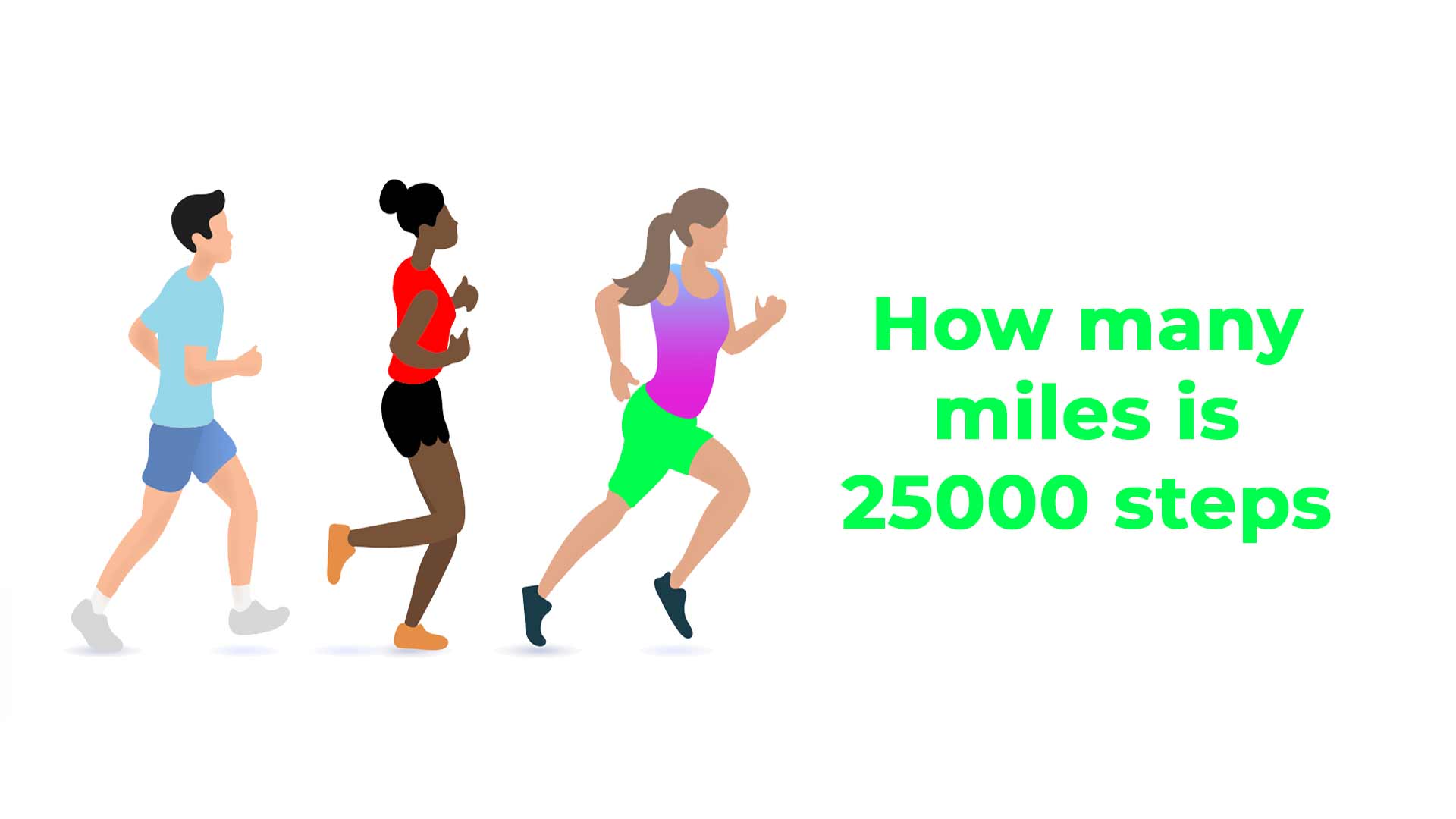Do you know How many miles is 25000 steps? In today’s fast-paced world, where health and fitness are paramount, tracking our daily activity has become second nature. Whether you’re a fitness enthusiast, someone looking to shed a few pounds, or just eager to lead a healthier lifestyle, keeping tabs on your step count has likely become a daily ritual.
One often-heard benchmark is the coveted 10,000 steps a day, touted as a recipe for good health. But what if you take it a step further? What if you’re aiming for 15,000, 20,000, or even 25,000 steps in a single day? It’s a challenging goal that many fitness-conscious individuals strive to achieve.
In this comprehensive guide, we’re going to dive into the nitty-gritty details of what it truly means to walk 25,000 steps. We will cover how many miles is 25000 steps and all the details related to it. All the information and data shown in this blog are based on the words from John Markell and Aaron Charnay. Moreover, they validated the information present in this blog.
“25,000 steps would be approximately equal to 11.81 miles.”
How many miles is 25000 steps?

The number of miles covered by a specific number of steps depends on the average stride length of the person taking those steps. Also, the height of the person influences the steps-to-mile conversion. The commonly used estimate is that approximately 2,000 steps are equivalent to one mile, assuming an average stride length of about 2.5 feet. However according to John Markell, 2118 steps are equal to 1 mile based on this research.
1 mile = 2,118 steps
Now, to find out how many miles are covered by 25,000 steps, we can set up a proportion:
(1 mile / 2,118 steps) = (X miles / 25,000 steps)
To solve for X (the number of miles covered by 25,000 steps), we can cross-multiply and divide:
X miles = (1 mile / 2,118 steps) * 25,000 steps
X miles ≈ 11.81 miles
So, 25,000 steps would be approximately equal to 11.81 miles if we use the conversion rate of 2,118 steps per mile.
How many miles in 25000 steps for different height ranges?
let’s calculate how many miles are covered by 25,000 steps for each of these height ranges:
- For Height Range 6.00 to 7.00 Feet (2,031 steps per mile): X miles = (1 mile / 2,031 steps) * 25,000 steps X miles ≈ 12.29 miles
- For Height Range 5.50 to 6.00 Feet (2,095 steps per mile): X miles = (1 mile / 2,095 steps) * 25,000 steps X miles ≈ 11.91 miles
- For Height Range 4.50 to 5.50 Feet (2,118 steps per mile): X miles = (1 mile / 2,118 steps) * 25,000 steps X miles ≈ 11.81 miles
- For Height Range 3.00 to 4.50 Feet (2,135 steps per mile): X miles = (1 mile / 2,135 steps) * 25,000 steps X miles ≈ 11.69 miles
So, the number of miles covered by 25,000 steps can vary depending on a person’s height:
- For individuals in the 6.00 to 7.00 feet height range, it’s approximately 12.29 miles.
- For individuals in the 5.50 to 6.00 feet height range, it’s approximately 11.91 miles.
- For individuals in the 4.50 to 5.50 feet height range, it’s approximately 11.81 miles.
- For individuals in the 3.00 to 4.50 feet height range, it’s approximately 11.69 miles.
These calculations take into account the different stride lengths associated with each height range.
How many calories will you burn if you walk 25000 Steps?

To calculate the number of calories burned while walking 25,000 steps, we can use the information that 2,118 steps are approximately equal to 1 mile and that you burn 102 to 105 calories per mile.
Let’s calculate the calories burned using the range provided:
- Calculate the number of miles covered: 25,000 steps / 2,118 steps per mile ≈ 11.81 miles
- Calculate the calories burned using the lower and upper end of the calorie range:
- Lower end: Calories burned = 11.81 miles * 102 calories per mile ≈ 1,204.62 calories
- Upper end: Calories burned = 11.81 miles * 105 calories per mile ≈ 1,239.05 calories
So, if you walk 25,000 steps, you would burn approximately 1,204.62 to 1,239.05 calories, depending on your individual energy expenditure and walking speed within the given range of calories per mile.
You can try our Step to Mile Calculator and Steps to Km Converter.
How many calories will you burn if you run 25000 steps?

To calculate the number of calories burned while running 25,000 steps, we can use the information that 2,118 steps are approximately equal to 1 mile and that running typically burns around 150 to 210 calories per mile.
Let’s calculate the calories burned using the range provided:
- Calculate the number of miles covered: 25,000 steps / 2,118 steps per mile ≈ 11.81 miles
- Calculate the calories burned using the lower and upper end of the calorie range:
- Lower end: Calories burned = 11.81 miles * 150 calories per mile ≈ 1,771.5 calories
- Upper end: Calories burned = 11.81 miles * 210 calories per mile ≈ 2,479.1 calories
So, if you run 25,000 steps, you would burn approximately 1,771.5 to 2,479.1 calories, depending on your individual energy expenditure and running speed within the given range of calories per mile.
What are the health benefits of walking 25k steps?
Walking 25,000 steps a day can have numerous health benefits. Here’s an elaboration on the potential advantages:
Weight Management:
Walking 25,000 steps burns a significant number of calories, aiding in weight loss or maintenance. It helps create a calorie deficit, which is essential for shedding pounds.
Cardiovascular Health:
Walking is a cardiovascular exercise that enhances heart health. It can lower the risk of heart diseases, decrease blood pressure, and improve cholesterol levels.
Improved Fitness:
Regular walking at this level can increase your endurance and overall fitness. It strengthens muscles, improves stamina, and enhances lung capacity.
Mental Well-being:
Physical activity like walking releases endorphins, which can boost mood and reduce symptoms of anxiety and depression. It’s also a great way to reduce stress.
Better Sleep:
Walking can contribute to better sleep quality. It helps regulate sleep patterns and can reduce insomnia.
Joint Health:
Unlike high-impact activities, walking is gentle on the joints. It can even alleviate joint pain and stiffness in some cases.
Digestive Health:
Walking can aid in digestion and prevent constipation. The movement helps food travel through the digestive tract efficiently.
Enhanced Cognitive Function:
Regular physical activity, including walking, is associated with improved cognitive function and a reduced risk of cognitive decline as you age.
Increased Energy Levels:
Surprisingly, expending energy through physical activity can lead to increased energy levels throughout the day. It can help you feel more awake and alert.
Social Interaction:
Walking can be a social activity. Walking with friends or in groups can enhance your social life and support a sense of community.
Longevity:
Several studies suggest that regular walking is associated with increased longevity. It’s a simple and sustainable way to promote a longer, healthier life.
Bone Health:
Weight-bearing activities like walking can strengthen bones, reducing the risk of osteoporosis.
Immune System Support:
Moderate exercise like walking may improve the immune system’s ability to defend against illnesses.
How long will it take to walk 25000 steps?
To calculate how long it will take to walk 25,000 steps at a range of walking speeds from 3 to 5 miles per hour, we can use the information that 2,118 steps are approximately equal to 1 mile.
Let’s calculate the time it takes for each speed within the range:
- At a walking speed of 3 miles per hour:
- 25,000 steps / (2,118 steps per mile) / (3 miles per hour) = approximately 3.94 hours
- At a walking speed of 4 miles per hour:
- 25,000 steps / (2,118 steps per mile) / (4 miles per hour) = approximately 2.96 hours
- At a walking speed of 5 miles per hour:
- 25,000 steps / (2,118 steps per mile) / (5 miles per hour) = approximately 2.37 hours
So, it will take approximately:
- 3.94 hours to walk 25,000 steps at 3 miles per hour.
- 2.96 hours to walk 25,000 steps at 4 miles per hour.
- 2.37 hours to walk 25,000 steps at 5 miles per hour.
How long will it take to run 25,000 steps?

To calculate how long it will take to run 25,000 steps at an average running speed ranging from 10 to 13 miles per hour, we can use the information that 2,118 steps are approximately equal to 1 mile.
Let’s calculate the time it takes for each speed within the range:
- At an average running speed of 10 miles per hour:
- 25,000 steps / (2,118 steps per mile) / (10 miles per hour) = approximately 1.18 hours
- At an average running speed of 11 miles per hour:
- 25,000 steps / (2,118 steps per mile) / (11 miles per hour) = approximately 1.08 hours
- At an average running speed of 12 miles per hour:
- 25,000 steps / (2,118 steps per mile) / (12 miles per hour) = approximately 1.00 hour
- At an average running speed of 13 miles per hour:
- 25,000 steps / (2,118 steps per mile) / (13 miles per hour) = approximately 0.92 hours
So, it will take approximately:
- 1.18 hours to run 25,000 steps at an average speed of 10 miles per hour.
- 1.08 hours to run 25,000 steps at an average speed of 11 miles per hour.
- 1.00 hour to run 25,000 steps at an average speed of 12 miles per hour.
- 0.92 hours to run 25,000 steps at an average speed of 13 miles per hour.
What are the recommended strategies for gradually increasing daily step counts to reach a goal of walking or running 25,000 steps a day?
To effectively increase your daily step count to reach a goal of 25,000 steps a day, consider the following strategies:
Set a Progressive Plan:
Start with your current daily step count and gradually increase it. For example, if you currently average 10,000 steps a day, aim for 12,000 or 13,000 steps in the first week, then add another 1,000 steps or more every week until you reach your goal.
Break It Into Sessions:
Instead of trying to do all 25,000 steps in one go, break your activity into sessions. Go for a walk in the morning, take a stroll during lunch, and have an evening walk. This way, it feels less daunting and more achievable.
Utilize Daily Activities:
Look for opportunities in your daily routine to add steps. Walk to the grocery store, take the stairs instead of the elevator, or do household chores that involve movement.
Incorporate Variety:
Mix up your activities to keep things interesting. Include not only walking but also jogging, cycling, swimming, or dancing. Different activities engage different muscle groups and prevent monotony.
Set a Schedule:
Plan your walks or runs into your daily schedule. Treat them as appointments you must keep, just like any other commitment.
Use Technology:
Invest in a pedometer or a fitness tracker to monitor your steps. Many of these devices come with apps that provide goal-setting features and reminders to keep you motivated.
Stay Consistent:
Consistency is key. Try to maintain a regular daily routine, even on weekends or rest days. This consistency helps build the habit of being active.
Join a Community:
Consider joining a walking or running group or an online community of like-minded individuals. Sharing your progress and challenges with others can provide motivation and support.
Hydration and Nutrition:
Stay well-hydrated throughout the day, especially if you’re increasing your physical activity. Ensure your diet includes a balance of nutrients to support your energy needs.
Listen to Your Body:
Pay attention to how your body responds to the increased activity. If you experience pain, fatigue, or discomfort, take it as a sign to adjust your plan, and consider consulting a healthcare professional if needed.
How can I effectively track and monitor my progress when aiming to achieve a daily goal of 25,000 steps?
Tracking and monitoring your progress when striving to achieve a daily goal of 25,000 steps can be crucial to your success. Here are several effective strategies:
Wearable Fitness Trackers:
Consider investing in a wearable fitness tracker like a Fitbit, Apple Watch, or Garmin device. These devices are equipped with accelerometers and sensors that accurately count your steps throughout the day. They also provide detailed data, such as distance walked, calories burned, and even heart rate in some cases. Sync your device with a corresponding mobile app or computer software to keep a comprehensive record of your daily steps. If you are an iPhone user, you can use Pedometer & Step Counter. Its a good step counting app for iOS devices.
Smartphone Apps:
There are numerous smartphone apps available, both for Android and iOS, that can turn your phone into a step counter. Popular options include Google Fit, Samsung Health, and various pedometer apps. These apps are convenient because you likely carry your phone with you everywhere, making step tracking effortless.
Pedometers:
Traditional pedometers are simple, low-cost devices that can be attached to your belt or clothing. While they may not provide as much data as fitness trackers or apps, they offer a basic step count. Some modern pedometers are more advanced and can sync with smartphone apps to provide additional insights.
Online Dashboards:
Some fitness trackers and apps offer online dashboards or web portals where you can review your step history and progress over time. These platforms may also allow you to set and adjust step goals, making it easier to stay motivated.
Manual Logging:
If you prefer a low-tech approach, you can manually log your steps in a journal or spreadsheet. Create a daily log where you record your step count at various intervals throughout the day. This method requires diligence and consistency but can be effective.
Social Media and Communities:
Join online fitness communities or use social media platforms to share your progress with friends or like-minded individuals. Many fitness apps and wearables allow you to connect with others, fostering a sense of accountability and friendly competition.
Scheduled Check-Ins:
Set aside specific times during the day to check your step count. This can help you gauge your progress and adjust your activity level if needed. For example, you might check your steps after your morning walk, at lunchtime, and in the evening.
Daily Reminders:
Use alarms or notifications on your phone or smartwatch to remind you to move and check your step count regularly. These reminders can encourage you to stay active throughout the day.
Sync with Health Apps:
If you’re focused on overall health and fitness, consider using apps that integrate step data with other health metrics like sleep quality, nutrition, and weight management. This holistic approach can provide a more comprehensive view of your well-being.

